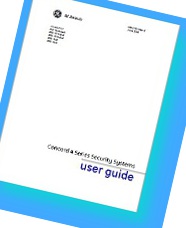- Home
- Compare Systems
- Cheap Systems
- Free Quotes
- DIY Systems
- Hardwired Systems
- Wireless Systems
- Smoke Detectors
- Medical Alarms
- Alarm Monitoring
- Cameras & Video
- Ademco
- ADT Security
- Brinks Security
- Broadview
- DSC Security
- FBI Alarms
- GE Security
- Honeywell
- Link Interactive
- Monitronics
- Moose
- Napco
- Protection 1
- Radionics
- Simplisafe
- Alarm Manuals
- Alarm System Parts
- Alarm Tools
- Troubleshooting
- FAQ
- Glossary
- Sitemap
- About Me
- Contact Me
GE Concord 4
Security System
The GE Concord 4 is a panel that has become a favorite among do-it-yourselfers and pro’s alike, and for good reason. Made by General Electric Products / GE Interlogix, the Concord 4 is a hybrid panel, meaning it can use both hardwire contacts and wireless sensors. This capability allows it to “cover all of the bases,” regardless of the type of home it will be installed in.
Looking for a less expensive, smaller system? Check out this page on GE Caddx alarm systems.
For a wireless system using up to 24 zones, consider a GE Simon 3 alarm system.
Basic features include:
- 96-Zone wireless capacity
- 8-Hardwired zones on board. Connect additional zones using the GE Interlogix Superbus Zone Hardwire Input Module
- A 2-Wire smoke detector loop (up to 20 detectors)
- 2 Programmable outputs
- 8 User codes
- 6 Partitions
The Concord 4 can be used strictly as a wireless alarm system, making it a good choice for a rental, two-story, or flat-roof home where running wires is not an option.
The Concord alarm can also be configured as a hardwired security system, eliminating the additional costs and battery changes of wireless transmitters.
Really though, one of the best ways to let the Concord 4 shine is by using a combination of both its hardwired and wireless capabilities.
GE Concord 4 Hardwired Configuration, with Selected Wireless Accessories
As one example, you could use the Concord in a mostly-hardwired configuration, using hardwired magnetic contacts for all the doors and windows. Hardwired keypads, motion detectors, glassbreaks, and smoke detectors would complete the main system. So far, a good hardwired alarm system.
Then, add wireless keyfobs and/or a wireless touchpad to give you maximum convenience for arming, disarming, and controlling the system.
Concord 4 Wireless Setup, with Selected Hardwired Portions
For a mostly-wireless configuration, use wireless door and window sensors, motion detectors, and other devices to build the system. Next, see if there are any areas that could benefit from a short wire run. Good examples are a garage door, motion detector, or smoke detector located near the main Concord 4 panel location.
By adding limited hardwired runs where possible, you can reduce the number of wireless devices (and their batteries) you use in the system. A frequently used garage door will use batteries much faster than a window you rarely use. By hardwiring the door, you save the cost of a transmitter and the hassle of replacing its battery.
GE Concord 4 Macro Feature
Macros are simply pre-programmed sequences of keystrokes, saved as a group in the alarm panel memory. They are used to simplify repetitive key presses needed for certain functions of the system.
Macros are often used for customized arming of a security system. For example, when you are arming the alarm for the night, you might still want access to a safe room or gun storage area in the home. When you are away from home, you’d probably like these areas secured by the alarm along with the rest of the house.
You could set up a macro that would execute the following sequence:
- Bypass the safe room or gun storage area;
- Bypass a door or motion detector you would have to pass through to reach the area;
- Arm the system
When you’re ready to arm while staying in, just trigger the macro to set all of the above commands in motion automatically. The macro performs the custom-bypasses and arms the system, without you having to enter all the repetitive button presses.
Macros are added and used through the GE Concord 4 keypad, model
ATP1000 Alphanumeric Touchpad. This keypad has 4 buttons for holding
macros, and each macro can store a sequence of up to 14 keystrokes.
Other uses for macros include:
- Bypassing doors to allow access to the patio, while the front of the house is armed
- Bypassing upstairs doors, windows, or motion detectors, leaving the downstairs fully protected
- Arming a garage, workshop, or guest room separately from the main house
Many professional home alarm companies use the Concord 4. It’s also
widely available in various kits and packages if you’re considering a
DIY security system.
If you haven't done so already, get a few Free Home Security Systems Quotes from companies in your area.
This will give you a good idea of what it would cost to have a system installed, as well as how much you could save by doing it yourself.
Find a GE Concord 4 Users Guide at GE Interlogix.com.
Related Articles:
GE Security Simon XT
Another popular “hybrid” system, the Ademco Vista 20P
GE Simon 3 Alarm System
GE Caddx Alarm Systems
Basics of Hardwired Home Security Systems
Basics of Wireless Home Alarm Systems
Return to GE Home Security Systems from GE Concord 4
Return to Home Security Systems Answers from GE Concord 4
Note: Feel free to print any of the articles on this site for personal, non-commercial use. Just look for this button:
If you found this website especially helpful, you might want to consider making a small donation. Since 2011, AzAlarmGuy has been providing free help and advice on home security systems to all of those in need.
Your gift, in any amount, will help me keep this website a free resource for anyone needing help with alarm system issues or questions.
Disclosure
I receive affiliate commissions from some of the companies and products I discuss. These commissions don't change the price that you pay.
Rest assured that this compensation does not influence my recommendations. I only endorse products and services that I truly believe to be an honest value for you, as a visitor to my site.
For more details, see my full disclaimer.






